The Refined Consensus Model of Pedagogical Content Knowledge (PCK): Detecting Filters between the Realms of PCK
Abstract
:1. Introduction
1.1. The Refined Consensus Model of PCK
1.1.1. Three Realms of PCK
1.1.2. Assumed Transformation Processes between the Realms of PCK
Motivational Orientations and Professional Values as Filter 1
Noticing and Knowledge-Based Reasoning as Filter 2
1.2. Language in Science Education
1.3. The RCM and the Example of Language in Biology Education
2. Hypotheses
2.1. Filter 1 between cPCK and pPCK
2.2. Filter 2 between pPCK and ePCK
3. Methods
3.1. Setting
3.2. Sample
3.3. Design and Procedure
3.4. Test Instruments
3.5. Data Analysis
3.5.1. Descriptive Analyses
3.5.2. Moderation Analyses
4. Results
4.1. Correlations
4.2. Difference between pPCKpre and pPCKpost
4.3. Filter 1 between cPCK and pPCK
4.4. Filter 2 between pPCK and ePCK
5. Discussion and Implications
Author Contributions
Funding
Institutional Review Board Statement
Informed Consent Statement
Data Availability Statement
Conflicts of Interest
References
- Carlson, J.; Daehler, K.R. The Refined Concensus Model of Pedagogical Content Knowledge in Science Education. In Repositioning Pedagogical Content Knowledge in Teachers’ Knowledge for Teaching Science; Hume, A., Cooper, R., Boroswki, A., Eds.; Springer: Singapore, 2019; pp. 77–92. [Google Scholar]
- Berry, A.; Friedrichsen, P.; Loughran, J. (Eds.) Re-Examining Pedagogical Content Knowledge in Science Education; Routledge: New York, NY, USA; London, UK, 2015. [Google Scholar]
- Shulman, L.S. Those Who Understand: Knowledge Growth in Teaching. Educ. Res. 1986, 15, 4–14. [Google Scholar] [CrossRef]
- Prediger, S.; Wilhelm, N.; Büchter, A.; Gürsoy, E.; Benholz, C. Sprachkompetenz und Mathematikleistung—Empirische Untersuchung sprachlich bedingter Hürden in den Zentralen Prüfungen 10. Journal für Mathematik Didaktik 2015, 36, 77–104. [Google Scholar] [CrossRef]
- Baumert, J.; Kunter, M. Das Kompetenzmodell von COACTI. In Professionelle Kompetenz von Lehrkräften; Kunter, M., Baumert, J., Blum, W., Klusmann, U., Krauss, S., Neubrand, M., Eds.; Waxmann: Münster, Germany, 2011; pp. 29–54. [Google Scholar]
- Alonzo, A.C.; Berry, A.; Nilsson, P. Unpacking the Complexity of Science Teachers’ PCK in Action: Enacted and Personal PCK. In Repositioning Pedagogical Content Knowledge in Teachers’ Knowledge for Teaching Science; Hume, A., Cooper, R., Boroswki, A., Eds.; Springer: Singapore, 2019; pp. 271–286. [Google Scholar]
- Woolfolk Hoy, A.; Davis, H.; Pape, S.J. Teacher Knowledge and Beliefs. In Handbook of Educational Psychology; Alexander, P.A., Winne, P.H., Eds.; Routledge: New York, NY, USA, 2006; pp. 715–737. [Google Scholar]
- Kunter, M. Motivation als Teil der professionellen Kompetenz—Forschungsbefunde zum Enthusiasmus von Lehrkräften. In Professionelle Kompetenz von Lehrkräften; Kunter, M., Baumert, J., Blum, W., Klusmann, U., Krauss, S., Neubrand, M., Eds.; Waxmann: Münster, Germany, 2011; pp. 259–275. [Google Scholar]
- Oser, F. Wann lernen Lehrer ihr Berufsethos? In Die Institutionalisierung von Lehren und Lernen; Leschinsky, A., Ed.; Beltz: Weinheim, Germany, 1996; pp. 235–243. [Google Scholar]
- Wigfield, A.; Eccles, J.S. Expectancy-Value Theory of Achievement Motivation. Contemp. Educ. Psychol. 2000, 25, 68–81. [Google Scholar] [CrossRef] [PubMed]
- Mitchell, T.R. Matching Motivational Strategies with Organizational Contexts. Res. Organ. Behav. 1997, 19, 57–149. [Google Scholar]
- Baumert, J.; Kunter, M. Stichwort: Professionelle Kompetenz von Lehrkräften. ZfE 2006, 9, 469–520. [Google Scholar] [CrossRef]
- Gollan, T. Sozialer Einfluss auf Werthaltungen und seine Konsequenzen für kulturelle Diffusion. Ph.D. Thesis, Universität Hamburg, Hamburg, Germany, 2012. [Google Scholar]
- Mecheril, P.; Quehl, T. Die Sprache der Schule. Eine migrationspädagogische Kritik der Bildungssprache. In Sprache und Bildung in Migrationsgesellschaften: Machtkritische Perspektiven auf ein prekarisiertes Verhältnis; Thoma, N., Knappig, M., Eds.; Transcript: Bielefeld, Germany, 2015; pp. 151–177. [Google Scholar]
- Schmidt, B. Den Anti-Bias-Ansatz zur Diskussion stellen. Beitrag zur Klärung theoretischer Grundlagen in der Anti-Bias-Arbeit; BIS-Verlag der Carl von Ossietzky Universität: Oldenburg, Germany, 2009. [Google Scholar]
- Tajmel, T.; Hägi-Mead, S. Sprachbewusste Unterrichtsplanung. Prinzipien, Methoden und Beispiele für die Umsetzung; Waxmann: Münster, Germany; New York, NY, USA, 2017. [Google Scholar]
- Bardi, A.; Goodwin, R. The Dual Route to Value Change: Individual Processes and Cultural Moderators. J. Cross Cult. Psychol. 2011, 42, 271–287. [Google Scholar] [CrossRef]
- Calogero, R.M.; Bardi, A.; Sutton, R.M. A need basis for values: Associations between the need for cognitive closure and value priorities. Pers. Individ. Differ. 2009, 46, 154–159. [Google Scholar] [CrossRef]
- Meschede, N.; Fiebranz, A.; Möller, K.; Steffensky, M. Teachers’ Professional Vision, Pedagogical Content Knowledge and Beliefs: On its Relation and Differences Between Pre-Service and In-Service Teachers. Teach. Teach. Educ. 2017, 66, 158–170. [Google Scholar] [CrossRef]
- Sherin, M.G. Developing a Professional Vision of Classroom Events. In Beyond Classical Pedagogy. Teaching Elementary School Mathematics; Wood, T.L., Nelson, B.S., Warfield, J., Eds.; Routledge: New York, NY, USA, 2001; pp. 75–93. [Google Scholar]
- Sherin, M.G. The Development of Teachers’ Professional Vision in Video Clubs. In Video Research in the Learning Sciences; Goldman, R., Ed.; Erlbaum: Mahwah, NJ, USA, 2007; pp. 383–395. [Google Scholar]
- Stürmer, K.; Seidel, T. Assessing Professional Vision in Teacher Candidates. Zeitschrift für Psychologie 2015, 223, 54–63. [Google Scholar] [CrossRef]
- Seidel, T.; Stürmer, K. Modeling and Measuring the Structure of Professional Vision in Preservice Teachers. Am. Educ. Res. J. 2014, 51, 739–771. [Google Scholar] [CrossRef]
- Borko, H. Professional Development and Teacher Learning: Mapping the Terrain. Educ. Res. 2004, 33, 3–15. [Google Scholar] [CrossRef]
- Van Es, E.A.; Sherin, M.G. Learning to Notice: Scaffolding New Teachers’ Interpretations of Classroom Interactions. J. Technol. Teach. Educ. 2002, 10, 571–596. [Google Scholar]
- Santagata, R.; Yeh, C. The Role of Perception, Interpretation, and Decision Making in the Development of Beginning Teachers’ Competence. ZDM Math. Educ. 2016, 48, 153–165. [Google Scholar] [CrossRef]
- Blömeke, S.; Gustafsson, J.-E.; Shavelson, R.J. Beyond Dichotomies. Zeitschrift für Psychologie 2015, 223, 3–13. [Google Scholar] [CrossRef]
- Moschkovich, J.N. Academic Literacy in Mathematics for English Learners. J. Math. Behav. 2015, 40, 43–62. [Google Scholar] [CrossRef]
- Halliday, M.A.K. Learning How to Mean. Explorations in the Development of Language; Arnold: London, UK, 1975. [Google Scholar]
- Childs, P.E.; Markic, S.; Ryan, M.C. The Role of Language in the Teaching and Learning of Chemistry. In Chemistry Education. Best Practices, Opportunities and Trends; Garcia-Martinez, J., Serrano-Torregrosa, E., Eds.; Wiley-VCH: Weinheim, Germany, 2015; pp. 421–446. [Google Scholar]
- Riebling, L. Heuristik der Bildungssprache. In Herausforderung Bildungssprache—Und wie man sie meistert; Gogolin, I., Lange, I., Michel, U., Reich, H.H., Eds.; Waxmann: Münster, Germany, 2013; pp. 106–153. [Google Scholar]
- Nitz, S.; Nerdel, C.; Prechtl, H. Entwicklung eines Erhebungsinstruments zur Erfassung der Verwendung von Fachsprache im Biologieunterricht. ZfDN 2012, 18, 117–139. [Google Scholar]
- Taber, K.S. Exploring the Language(s) of Chemistry Education. Chem. Educ. Res. Pract. 2015, 16, 193–197. [Google Scholar] [CrossRef]
- Behling, F.; Förtsch, C.; Neuhaus, B.J. Sprachsensibler Biologieunterricht—Förderung professioneller Handlungskompetenz und professioneller Wahrnehmung durch videogestützte live-Unterrichtsbeobachtung. Eine Projektbeschreibung. ZfDN 2019, 25, 307–316. [Google Scholar] [CrossRef]
- Drumm, S. Sprachbildung im Biologieunterricht; De Gruyter Mouton: Berlin, Germany, 2016. [Google Scholar]
- Nitz, S.; Enzingmüller, C.; Prechtl, H.; Nerdel, C. Fachsprache im naturwissenschaftlichen Unterricht—Eine empirische Untersuchung zur Einstellung angehender Lehrkräfte. Unterrichtswissenschaft 2011, 39, 245–262. [Google Scholar]
- Retzlaff-Fürst, C. Protokollieren, Zeichnen und Mathematisieren. In Fachdidaktik Biologie; Gropengießer, H., Harms, U., Kattmann, U., Eds.; Aulis: Seelze, Germany, 2016; pp. 312–324. [Google Scholar]
- Kotzebue, L. von. Diagrammkompetenz als biologiedidaktische Aufgabe für die Lehrerbildung: Konzeption, Entwicklung und empirische Validierung eines Strukturmodells zum diagrammspezifischen Professionswissen im biologischen Kontext. Ph.D. Thesis, Technische Universität München, München, Germany, 2014. [Google Scholar]
- Mecheril, P.; Castro Varela, M.d.M.; Dirim, İ.; Kalpaka, A.; Melter, C. Migrationspädagogik; Beltz: Weinheim, Germany; Basel, Switzerland, 2010. [Google Scholar]
- Moore, F.M. Language in Science Education as a Gatekeeper to Learning, Teaching, and Professional Development. J. Sci. Teach. Educ. 2007, 18, 319–343. [Google Scholar] [CrossRef]
- Prediger, S. Sprachbildung im Fachunterricht, ja klar, aber was genau, und wie? Überblicke und Einblicke in mathematikspezifische empirische Studien. In Fachgespräch; Ludwig-Maximilians-Universität: München, Germany, 2017. [Google Scholar]
- Markic, S. Chemistry Teachers’ Pedagogical Scientific Language Knowledge. In Research, Practice and Collaboration in Science Education. Proceedings of ESERA 2017; Finlayson, O.E., McLoughlin, E., Erduran, S., Childs, P., Eds.; Dublin City University: Dublin, Ireland, 2018; pp. 178–185. [Google Scholar]
- Bunch, G.C. Pedagogical Language Knowledge. Rev. Res. Educ. 2013, 37, 298–341. [Google Scholar] [CrossRef]
- Tajmel, T. Naturwissenschaftliche Bildung in der Migrationsgesellschaft: Grundzüge einer Reflexiven Physikdidaktik und kritisch-sprachbewussten Praxis; Springer: Berlin, Germany, 2017. [Google Scholar]
- Eccles, J.S.; Adler, T.F.; Futterman, R.; Goff, S.B.; Kaczala, C.M.; Meece, J.L.; Midgley, C. Expectancies, Values, and Academic Behaviors. In Achievement and Achievement Motives. Psychological and Sociological Approaches; Spence, J.T., Ed.; W.H. Freeman: San Francisco, CA, USA, 1983; pp. 75–146. [Google Scholar]
- Förtsch, C.; Sczudlek, M.; Neuhaus, B.J. Kompetenzorientierung und Aufgabenkultur im Natur-und-Technik-Unterricht. Eine Videostudie. In Erkenntnisweg Biologiedidaktik 12; Krüger, D., Schmiemann, P., Möller, A., Dittmer, A., Zabel, J., Eds.; Universitätsdruckerei: Kassel, Germany, 2013; pp. 75–88. [Google Scholar]
- Boone, W.J.; Staver, J.R.; Yale, M.S. Rasch Analysis in the Human Sciences; Springer: Dordrecht, The Netherlands, 2014. [Google Scholar]
- Linacre, J.M. USCALE = The User-Scaled Value of 1 Logit = 1. Available online: https://winsteps.com/winman/uscale.htm (accessed on 13 July 2022).
- Linacre, J.M. What do Infit and Outfit, Mean-Square and Standardized Mean? RMT 2002, 16, 878. [Google Scholar]
- Wright, B.D.; Linacre, J.M. Reasonable Mean-Square Fit Values. RMT 1994, 8, 370. [Google Scholar]
- Boone, W.J.; Noltemeyer, A. Rasch Analysis: A Primer for School Psychology Researchers and Practitioners. Cogent. Educ. 2017, 4, 1416898. [Google Scholar] [CrossRef]
- Linacre, J.M. User’s Guide to Winsteps®Ministeps Rasch-Model Computer Programs. Program Manual 5.2.4. Available online: https://www.winsteps.com/a/Winsteps-Manual.pdf (accessed on 13 July 2022).
- Behling, F.; Förtsch, C.; Neuhaus, B.J. Using the Plan-Teach-Reflect Cycle of the Refined Consensus Model of PCK to Improve Pre-Service Biology Teachers’ Personal PCK as Well as Their Motivational Orientations. Educ. Sci. 2022; submitted. [Google Scholar]
- Jüttner, M.; Boone, W.; Park, S.; Neuhaus, B.J. Development and Use of a Test Instrument to Measure Biology Teachers’ Content Knowledge (CK) and Pedagogical Content Knowledge (PCK). Educ. Assess. Eval. Account. 2013, 25, 45–67. [Google Scholar] [CrossRef]
- Schmelzing, S.; van Driel, J.H.; Jüttner, M.; Brandenbusch, S.; Sandmann, A.; Neuhaus, B.J. Development, Evaluation, and Validation of a Paper-and-Pencil Test for Measuring Two Components of Biology Teachers’ Pedagogical Content Knowledge Concerning the “Cardiovascular System”. Int. J. Sci. Math Educ. 2013, 11, 1369–1390. [Google Scholar] [CrossRef]
- Jüttner, M.; Neuhaus, B.J. Das Professionswissen von Biologielehrkräften—Ein Vergleich zwischen Biologielehrkräften, Biologen und Pädagogen. ZfDN 2013, 19, 31–49. [Google Scholar]
- Jüttner, M.; Neuhaus, B.J. Validation of a Paper-and-Pencil Test Instrument Measuring Biology Teachers’ Pedagogical Content Knowledge by Using Think-Aloud Interviews. J. Educ. Train Stud. 2013, 1, 113–125. [Google Scholar] [CrossRef]
- Reeves, T.D.; Marbach-Ad, G. Contemporary Test Validity in Theory and Practice: A Primer for Discipline-Based Education Researchers. CBE Life Sci. Educ. 2016, 15. [Google Scholar] [CrossRef]
- Wiggins, G.P.; McTighe, J. Understanding by Design; Association for Supervision and Curriculum Development: Alexandria, VA, USA, 2005. [Google Scholar]
- Boone, W.; Rogan, J. Rigour in Quantitative Analysis: The Promise of Rasch Analysis Techniques. Afr. J. Res. Math. Sci. Technol. Educ. 2005, 9, 25–38. [Google Scholar] [CrossRef]
- Aryadoust, S.V. Mapping Rasch-Based Measurement onto the Argument-Based Validity Framework. Rasch Meas. Trans. 2009, 23, 1192–1193. [Google Scholar]
- Planinic, M.; Boone, W.J.; Susac, A.; Ivanjek, L. Rasch Analysis in Physics Education Research: Why Measurement Matters. Phys. Rev. Phys. Educ. Res. 2019, 15, 020111. [Google Scholar] [CrossRef]
- Mecheril, P.; Quehl, T. Sprache und Macht. Theoretische Facetten eines (migrations-)pädagogischen Zusammenhangs. In Die Macht der Sprachen. Englische Perspektiven auf die mehrsprachige Schule; Mecheril, P., Quehl, T., Eds.; Waxmann: Münster, Germany, 2006; pp. 355–381. [Google Scholar]
- Behling, F.; Förtsch, C.; Neuhaus, B.J. Biologieunterricht bewerten I: Vorstellung eines theoriebasierten Bewertungsbogens zur Qualitätseinschätzung von Artikulationsschemata. MNU J. 2021, 74, 508–512. [Google Scholar]
- Schröder, J.; Riese, J.; Vogelsang, C.; Borowski, A.; Buschhüter, D.; Enkrott, P.; Kempin, M.; Kulgemeyer, C.; Reinhold, P.; Schecker, H. Die Messung der Fähigkeit zur Unterrichtsplanung im Fach Physik mit Hilfe eines standardisierten Performanztests. ZfDN 2020, 26, 103–122. [Google Scholar] [CrossRef]
- Tajmel, T. Sprachliche Lernziele des naturwissenschaftlichen Unterrichts; Stiftung Mercator; Universität Duisburg-Essen: Duisburg, Germany, 2011; Available online: https://www.uni-due.de/imperia/md/content/prodaz/sprachliche_lernziele_tajmel.pdf (accessed on 13 July 2022).
- Gogolin, I.; Lange, I. Bildungssprache und durchgängige Sprachbildung. In Migration und schulischer Wandel: Mehrsprachigkeit; Fürstenau, S., Gomolla, M., Eds.; VS Verlag für Sozialwissenschaften: Wiesbaden, Germany, 2011; pp. 107–127. [Google Scholar]
- Dorfner, T.; Förtsch, C.; Neuhaus, B.J. Use of Technical Terms in German Biology Lessons and Its Effects on Students’ Conceptual Learning. Res. Sci. Technol. Educ. 2020, 38, 227–251. [Google Scholar] [CrossRef]
- Özayli, G.; Ortner, R. Wie über sich selbst nachdenken? Machtkritische Reflexionsperspektiven für Pädagog_innen im Kontext von Mehrsprachigkeit. In Sprache und Bildung in Migrationsgesellschaften: Machtkritische Perspektiven auf ein prekarisiertes Verhältnis; Thoma, N., Knappig, M., Eds.; Transcript: Bielefeld, Germany, 2015; pp. 205–219. [Google Scholar]
- Sandmann, A.; Schmiemann, P.; Neuhaus, B.J.; Tiemann, R. Fachdidaktische Strukturierung als Qualitätsmerkmal naturwissenschaftlichen Unterrichts: Sachstrukturen und Vernetzung, Kontext- und Aufgabenorientierung. In nwu-essen. 10 Jahre Essener Forschung zum naturwissenschaftlichen Unterricht; Fischer, H.E., Sumfleth, E., Eds.; Logos: Berlin, Germany, 2013; pp. 121–162. [Google Scholar]
- Beese, M.; Kleinpaß, A.; Krämer, S.; Reschke, M.; Rzeha, S.; Wiethoff, M. Praxishandbuch Sprachbildung in Biologie. Sprachsensibel unterrichten—Sprache fördern; Klett: Stuttgart, Germany, 2015. [Google Scholar]
- Gogolin, I. Chancen und Risiken nach PISA—Über Bildungsbeteiligung von Migrantenkindern und Reformvorschläge. In Schieflagen im Bildungssystem. Die Benachteiligung der Migrantenkinder; Auernheimer, G., Ed.; Springer Fachmedien: Wiesbaden, Germany, 2013; pp. 33–50. [Google Scholar]
- Hayes, A.F. Introduction to Mediation, Moderation, and Conditional Process Analysis. A Regression-Based Approach; The Guilford Press: New York, NY, USA; London, UK, 2018. [Google Scholar]
- Cohen, J. Statistical Power Analysis for the Behavioral Sciences; L. Erlbaum Associates: Hillsdale, MI, USA, 1988. [Google Scholar]
- Kunter, M.; Baumert, J.; Blum, W.; Klusmann, U.; Krauss, S.; Neubrand, M. (Eds.) Professionelle Kompetenz von Lehrkräften; Waxmann: Münster, Germany, 2011. [Google Scholar]
- Stürmer, K.; Könings, K.D.; Seidel, T. Declarative Knowledge and Professional Vision in Teacher Education: Effect of Courses in Teaching and Learning. Br. J. Educ. Psychol. 2013, 83, 467–483. [Google Scholar] [CrossRef]
- Santagata, R.; Guarino, J. Using Video to Teach Future Teachers to Learn from Teaching. ZDM Math. Educ. 2011, 43, 133–145. [Google Scholar] [CrossRef]
- Kersting, N.B.; Givvin, K.B.; Thompson, B.J.; Santagata, R.; Stigler, J.W. Measuring Usable Knowledge. Am. Educ. Res. J. 2012, 49, 568–589. [Google Scholar] [CrossRef]
- Kramer, M.; Förtsch, C.; Boone, W.J.; Seidel, T.; Neuhaus, B.J. Investigating Pre-Service Biology Teachers’ Diagnostic Competences: Relationships between Professional Knowledge, Diagnostic Activities, and Diagnostic Accuracy. Educ. Sci. 2021, 11, 89. [Google Scholar] [CrossRef]
- Tajmel, T.; Starl, K.; Schön, L.-H. Detect the Barriers and Leave Them Behind—Science Education in Culturally and Linguistically Diverse Classrooms. In Science Education Unlimited: Approaches to Equal Opportunities in Learning Science; Tajmel, T., Starl, K., Eds.; Waxmann: Münster, Germany, 2009; pp. 67–84. [Google Scholar]
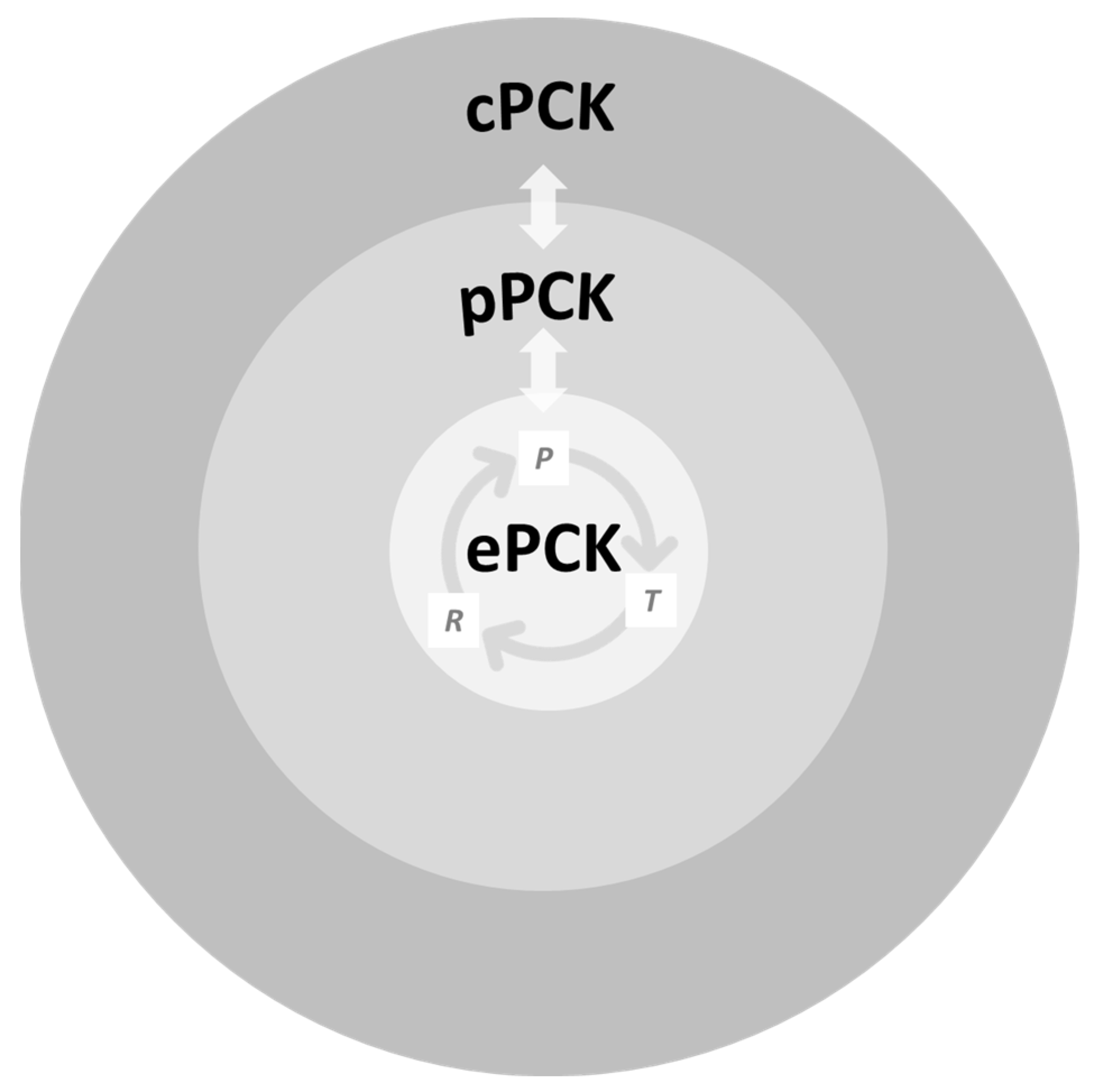

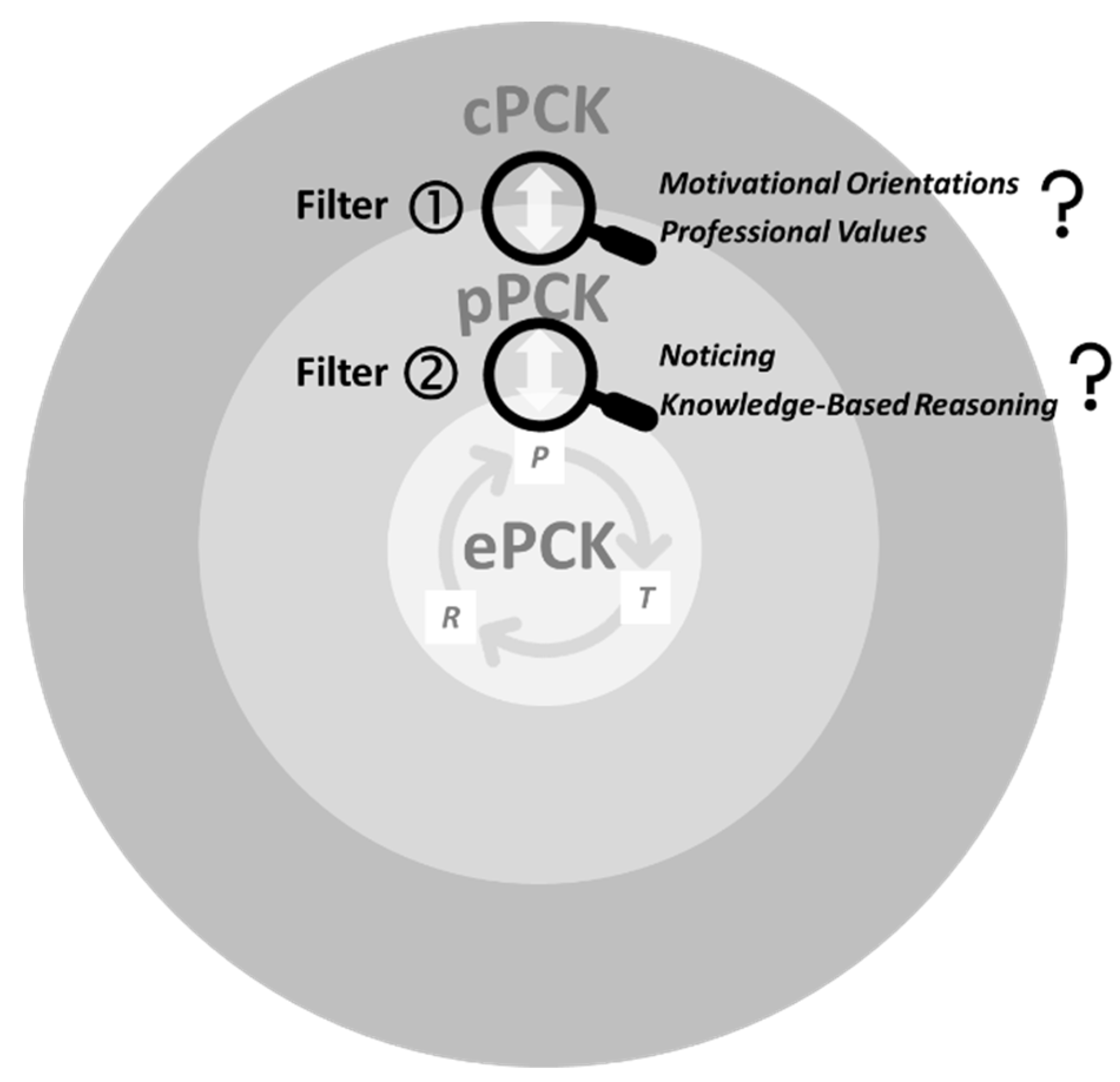
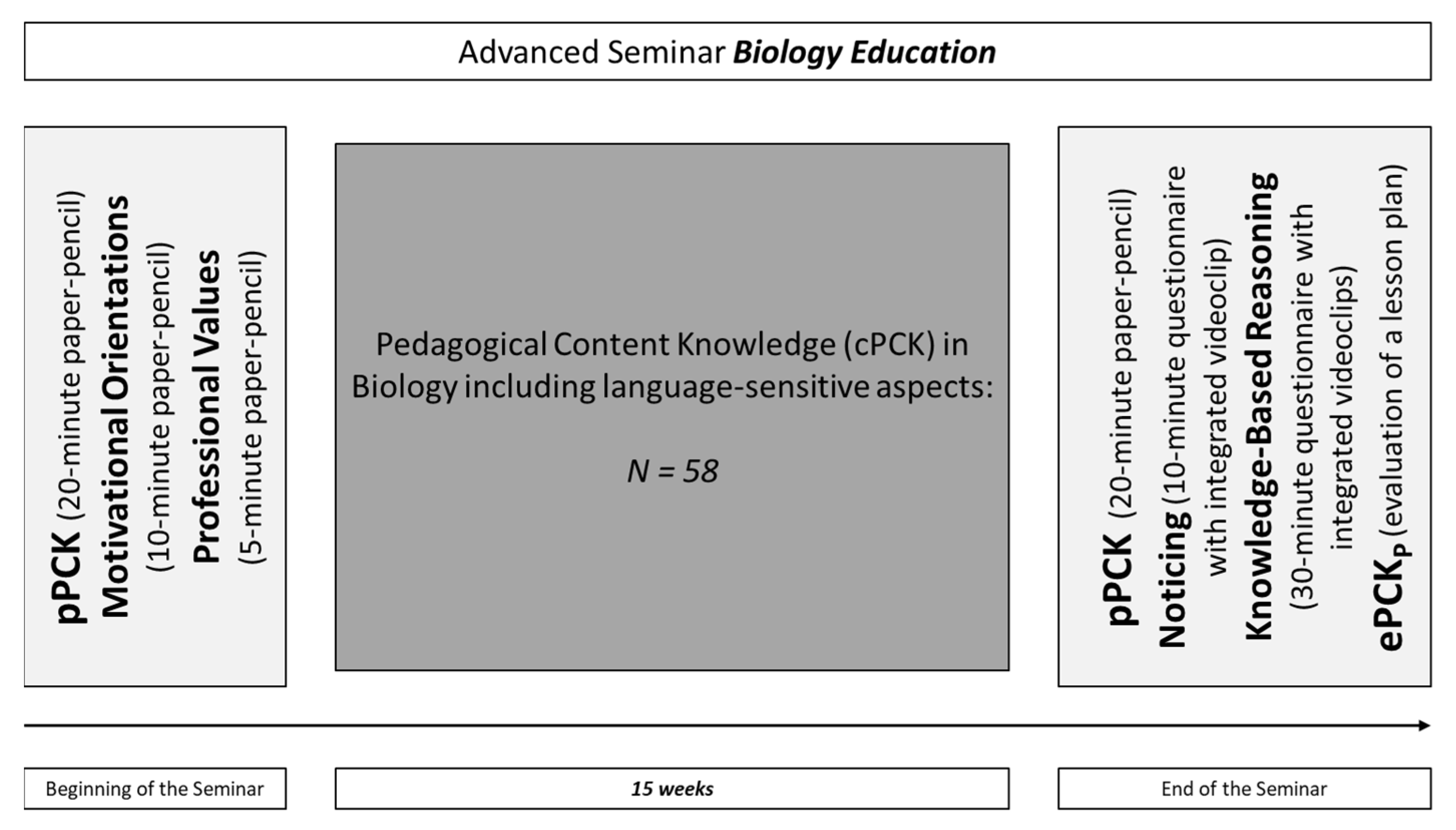
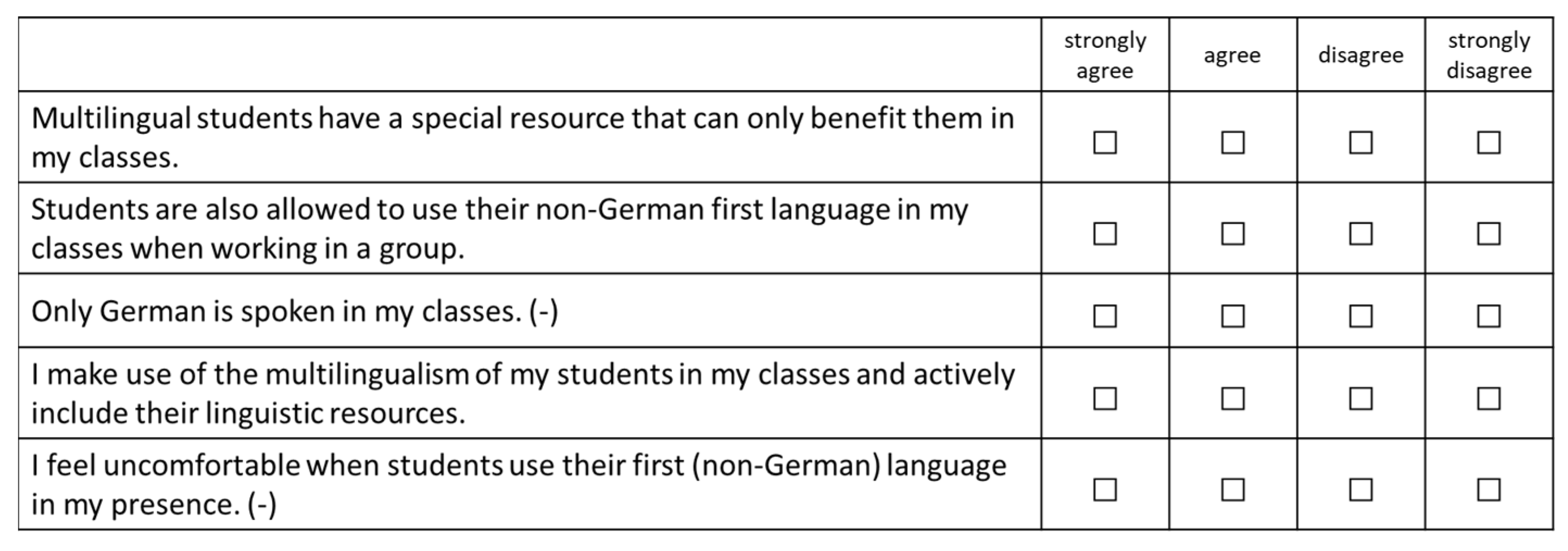

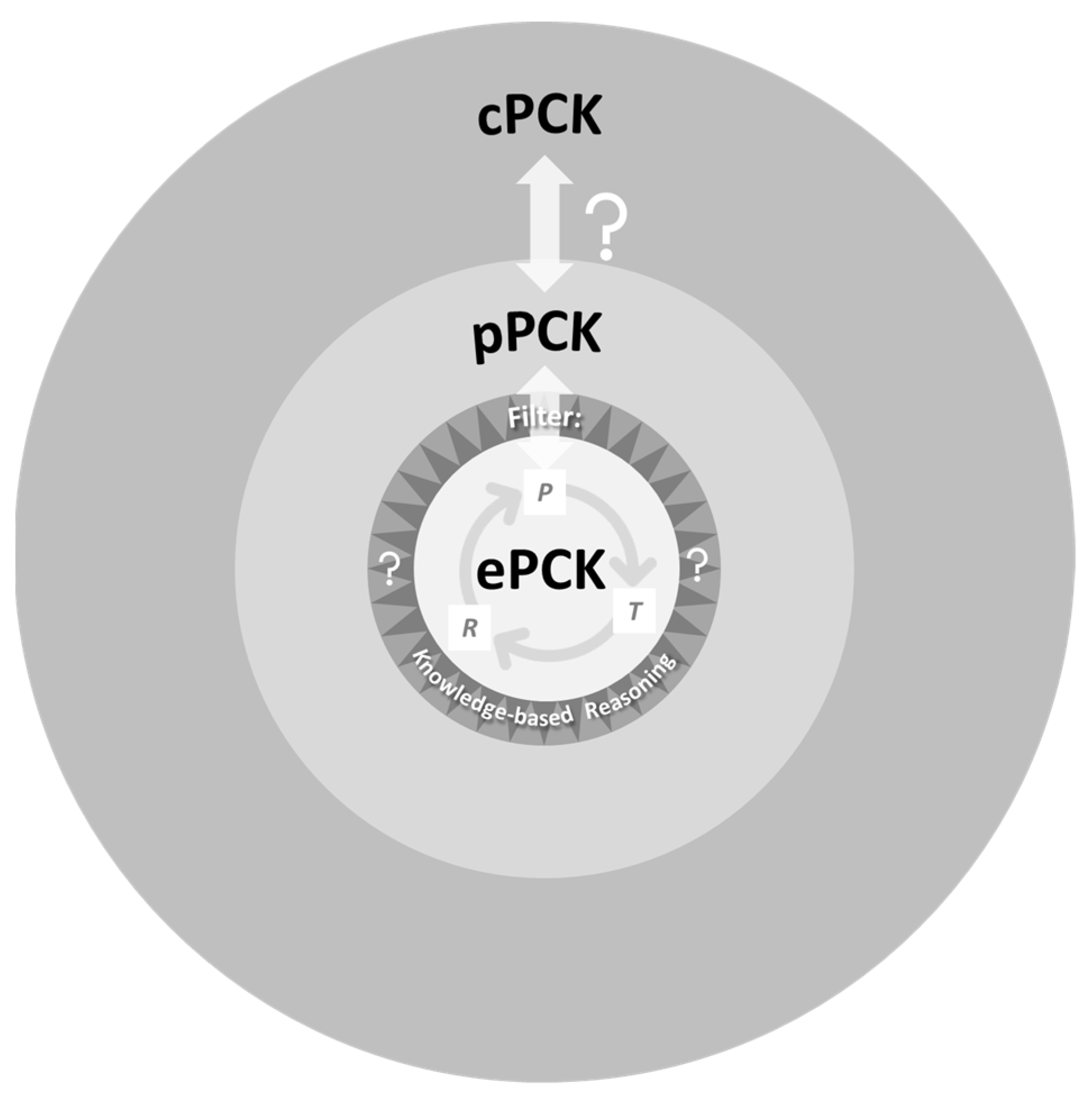
| Variable | Number of Items | All Item Infit MNSQ | All Item Outfit MNSQ | Item Reliability | Person Reliability | ICC (Unjust) |
|---|---|---|---|---|---|---|
| pPCK | N = 9 | <1.4 | <1.4 | 0.99 | 0.75 | ICC (159,159) = 0.97, p < 0.001 |
| Motivational Orientations | N = 34 | <1.4 | <1.4 | 0.98 | 0.88 | - |
| Professional Values | N = 27 | <1.3 | <1.3 | 0.98 | 0.76 | - |
| Noticing | N = 12 | <1.3 | <1.3 | 0.92 | 0.63 | - |
| Knowledge-Based Reasoning | N = 46 | <1.3 | <1.3 | 0.91 | 0.44 | - |
| ePCK | N = 8 | <1.5 | <1.5 | 0.97 | 0.86 | ICC (534,534) = 0.98, p < 0.001 |
| Mean of Person-Ability Score | SD | Min | Max | 1 | 2 | 3 | 4 | 5 | 6 | 7 | |
|---|---|---|---|---|---|---|---|---|---|---|---|
| 1 pPCKpre | 44.73 | 7.32 | 28.59 | 66.31 | 1 | ||||||
| 2 Motivational Orientations | 48.57 | 0.63 | 47.14 | 49.78 | - | 1 | |||||
| 3 Professional Values | 51.03 | 0.56 | 49.75 | 52.34 | - | 0.56 ** | 1 | ||||
| 4 pPCKpost | 47.74 | 5.46 | 31.71 | 64.99 | 0.64 ** | 0.36 * | - | 1 | |||
| 5 ePCKP | 68.51 | 7.65 | 36.91 | 80.84 | - | −0.29 * | - | −0.31 * | 1 | ||
| 6 Noticing | 50.39 | 1.57 | 46.57 | 54.78 | - | - | - | - | - | 1 | |
| 7 Knowledge-Based Reasoning | 51.33 | 1.12 | 50.74 | 56.50 | - | - | - | - | - | 0.62 ** | 1 |
| Hypothesis | Independent Variable | Dependent Variable | Moderator Variable | R2 | F | p | 95% CI |
|---|---|---|---|---|---|---|---|
| 1a | pPCKpre | pPCKpost | Motivational Orientations | 1.27% | F(1,44) = 0.68 | 0.41 | [−0.2222, 0.3591] |
| 1b | pPCKpre | pPCKpost | Professional Values | 0.48% | F(1,44) = 0.17 | 0.68 | [−0.3178, 0.4375] |
| 2a | pPCKpost | ePCK | Noticing | 5.56% | F(1,19) = 0.40 | 0.53 | [−1.7464, 0.9203] |
| 2b | pPCKpost | ePCK | Knowledge-Based Reasoning | 12.95% | F(1,19) = 12.53 | < 0.01 | [−0.5034, 5.3879] |
Publisher’s Note: MDPI stays neutral with regard to jurisdictional claims in published maps and institutional affiliations. |
© 2022 by the authors. Licensee MDPI, Basel, Switzerland. This article is an open access article distributed under the terms and conditions of the Creative Commons Attribution (CC BY) license (https://creativecommons.org/licenses/by/4.0/).
Share and Cite
Behling, F.; Förtsch, C.; Neuhaus, B.J. The Refined Consensus Model of Pedagogical Content Knowledge (PCK): Detecting Filters between the Realms of PCK. Educ. Sci. 2022, 12, 592. https://doi.org/10.3390/educsci12090592
Behling F, Förtsch C, Neuhaus BJ. The Refined Consensus Model of Pedagogical Content Knowledge (PCK): Detecting Filters between the Realms of PCK. Education Sciences. 2022; 12(9):592. https://doi.org/10.3390/educsci12090592
Chicago/Turabian StyleBehling, Franziska, Christian Förtsch, and Birgit J. Neuhaus. 2022. "The Refined Consensus Model of Pedagogical Content Knowledge (PCK): Detecting Filters between the Realms of PCK" Education Sciences 12, no. 9: 592. https://doi.org/10.3390/educsci12090592
APA StyleBehling, F., Förtsch, C., & Neuhaus, B. J. (2022). The Refined Consensus Model of Pedagogical Content Knowledge (PCK): Detecting Filters between the Realms of PCK. Education Sciences, 12(9), 592. https://doi.org/10.3390/educsci12090592






